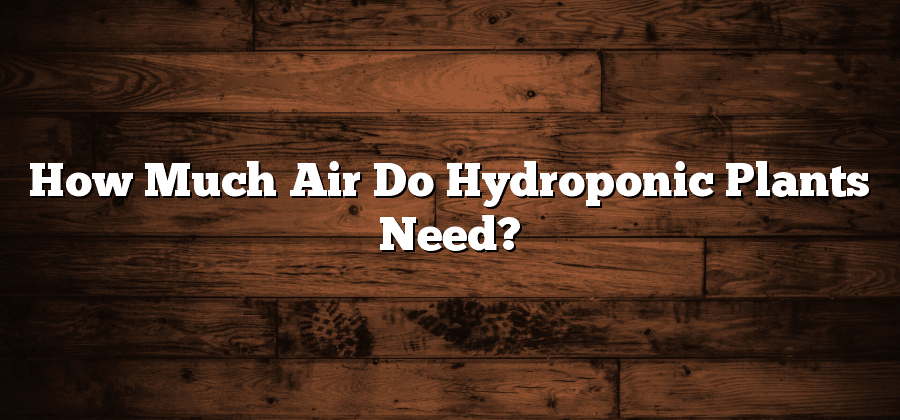Importance of proper air circulation in hydroponics
Proper air circulation is an essential factor in achieving success in hydroponics. The plants that thrive in hydroponic systems rely on a consistent supply of oxygen to their roots, and without adequate air circulation, the oxygen levels can quickly become depleted. When plants are not receiving sufficient oxygen, their growth and overall health may be compromised, leading to lower yields and poor quality produce.
The importance of air circulation in hydroponics cannot be overstated. It not only ensures the delivery of oxygen to the plants’ roots but also helps in preventing the buildup of stagnant air, excess humidity, and the occurrence of harmful pathogens. By maintaining proper airflow in the hydroponic environment, growers can create an optimal growing condition for their plants, allowing them to absorb essential nutrients efficiently and grow vigorously.
In conclusion, air circulation plays a vital role in the success of hydroponic systems by providing a steady supply of oxygen to the plants’ roots and promoting a healthy growing environment. By understanding the significance of proper airflow and implementing techniques to increase air circulation, hydroponic growers can maximize their plant’s growth potential and achieve high-quality yields.
Factors affecting the air requirements of hydroponic plants
To ensure optimal growth, hydroponic plants require a well-regulated air supply within their growing environment. Several factors can influence the air requirements of these plants. One such factor is the type of hydroponic system being used. Different systems, such as nutrient film technique (NFT), deep water culture (DWC), and aeroponics, have varying levels of air exposure and circulation. For example, in NFT systems, where nutrient-rich water flows over plant roots, there is less need for a high volume of air circulation compared to aeroponic systems, where the roots are suspended in air and misted with nutrient solutions.
Another factor that affects air requirements is the stage of plant growth. Plants in the vegetative stage may require more air circulation compared to those in the flowering or fruiting stage. This is because rapid growth in the vegetative stage requires more oxygen for root respiration and to support the increased metabolic demands of the plant. As the plant transitions into the flowering or fruiting stage, its oxygen needs may decrease, and adjustments in air circulation may be necessary. Therefore, it is crucial to monitor the plant’s growth stage and adjust the air supply accordingly to meet its changing requirements.
The role of oxygen in hydroponic systems
Hydroponic systems rely on the proper circulation of oxygen to support the growth and development of plants. Oxygen plays a crucial role in providing essential nutrients to the roots, facilitating nutrient uptake, and promoting overall plant health. Without sufficient oxygen levels, the roots may become deprived, leading to root rot, stunted growth, and even plant death.
The availability of oxygen in hydroponic systems is directly influenced by various factors, including water temperature, dissolved oxygen levels, and the efficiency of aeration methods. Maintaining an adequate level of dissolved oxygen in the nutrient solution is of utmost importance. This can be achieved through the use of air stones, diffusers, or other aeration devices to promote oxygenation. Additionally, monitoring and regulating the water temperature within optimal ranges can help prevent oxygen depletion and maintain a healthy hydroponic environment. By understanding the role of oxygen and implementing effective oxygenation techniques, hydroponic growers can ensure that their plants receive the necessary oxygen to thrive.
Understanding the oxygenation needs of hydroponic plants
The oxygenation needs of hydroponic plants play a vital role in their overall health and growth. Unlike their counterparts in soil, hydroponic plants do not have easy access to oxygen from the surrounding environment. Instead, they rely on the nutrient solution that circulates around their root system to provide them with the necessary oxygen.
Proper oxygenation is crucial for hydroponic plants as it directly affects their ability to absorb nutrients and carry out essential processes like respiration and photosynthesis. Without sufficient oxygen, the roots can become waterlogged and suffocate, leading to root rot and poor plant development. Therefore, it is crucial for hydroponic growers to understand the oxygenation needs of their plants and implement appropriate techniques to ensure their well-being.
Techniques for increasing air circulation in hydroponic setups
One effective technique for increasing air circulation in hydroponic setups is the use of oscillating fans. These fans are positioned strategically within the grow space to constantly move air around. The oscillating feature ensures that air reaches all parts of the plants, preventing the buildup of stagnant air pockets. By promoting air movement, oscillating fans help to strengthen the stems and leaves of the plants, making them more resistant to diseases and pests. Additionally, the gentle breeze created by the fans mimics natural outdoor conditions, which can encourage more robust growth.
Another method for increasing air circulation is the installation of exhaust fans or vents. These fans or vents are typically placed near the top of the grow space, allowing hot, stale air to escape while drawing in fresh air from outside. This exchange of air helps to maintain optimal temperature and humidity levels within the hydroponic system. Additionally, the constant inflow of fresh air brings in a fresh supply of oxygen, which is essential for the respiration process of the plants. Installing exhaust fans or vents can also help to control the buildup of excess humidity and prevent the growth of mold or mildew.






